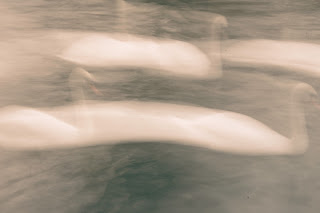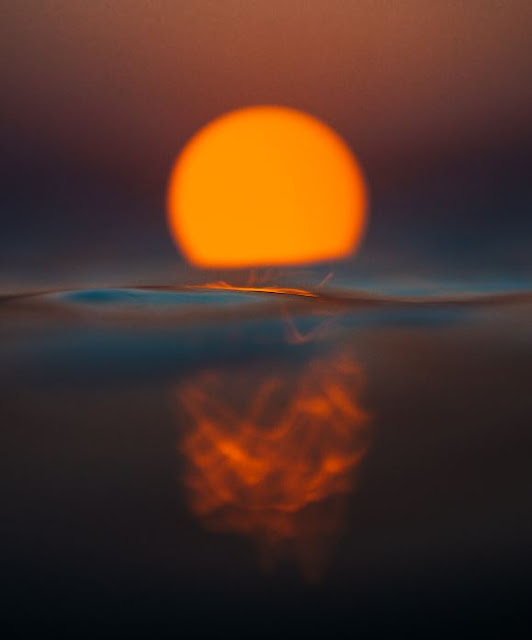In today's class we started to talk about long exposure photography and how to shoot street photography at night. Then we discussed on color theory in photography. We had a look at saturation, accent colors, contrast and light. Then we see examples how photographers use this. To begin my 'the city at night' journey I will first do the research and then capture my own images. At night, cities shimmer and come alive, making them a fantastic subject for photography. There are, however, many more limitations to work around, certain settings to employ, and, depending on what shooting we should have to push camera to its limits.
I want to start with research here about Michael Palazzo photographer, which in his portfolio has "Venezia by night" series of images. I'm looking at his work because I can find inspiration and he is a good example of night shooting. He describes himself: "I'm Italian by blood, an Architect by training, and Photographer by heart. A visual storyteller, weaving narratives through people’s movements and emotions."
Michael Palazzo - Venezia by night
Michael Palazzo - Venezia by night
Michael Palazzo - Venezia by night
Michael Palazzo - Venezia by night
Michael Palazzo - Venezia by night
In my opinion we can see beautiful contrast between light and the dark city. It creates peaceful and in the same time mysterious climate. Even though we can't see people around we can see that city is still alive and attractive by lights in it.
As Palazzo says:
"when I seek another definition for ‘peace,’ I never find any better description than ‘Venezia by night.’ Another Venezia appears at night when all the tourists are gone.".
'Color gives emotion'
Color and light are strongly important in photography. The color of light in photographs gives viewers information about the image. Only the facts and information included within the generated frame are available to the viewer. The emotion that an image produces for the person viewing it is influenced by color. (Pete, 2021).
Color is a reflection of light. It is formed by absorbing and reflecting light off a surface or through a transparent substance. The wavelengths of light that the human eye absorbs and processes from a reflected source are known as colors. When we see a color, we are seeing reflected light from a certain region of the spectrum.
Colors are affected by a variety of things in photography, including the time of day, season, light, weather, and camera abilities and equipment. A photographer must grasp the origins of colors and how they are perceived. Also be aware of how light can change color and shape.
We can highlight color harmony, complementary colors, analogous colors, monochromatic and then color contrast and white balance.

White balance
A digital photograph's white balance is adjusted to make colours appear more realistic. It's a technique for neutralizing a photograph or making white appear white. In bright light, a photo of snow, for example, can appear bluer than it actually is. To avoid the blue cast, we use post-production tools to remove it. Tools like Adobe Lightroom, Photoshop, and similar picture editing programmes allow more control for genuinely correct white balance.
The color of light is commonly referred to as color temperature. The temperature at which a black body an object that totally absorbs all waves of light — emits radiation of the same hue as any given object is known as color temperature. Kelvin is a unit of measurement for color temperature (K). The "colder" or whiter the light is, the higher the number. The hue of the light emitted follows a roughly linear progression of red orange, red yellow, yellow white, white, blue and white.
white balance adjusted
As I am passionate about cooking and food I set up myself the theme for night shooting 'Restaurants Windows". Here I add my images and add EXIF details, then I add reflection.
Canon EOS700D f/5.6 1/50sec ISO 6400 focal length 55mm
This photo I consider the best one. I like the warm light in it. I captured people during the dinner. I can see wonderful atmosphere in this place. There is a purple light in it. In my opinion light in restaurant plays important role. It can attract guests and make them feel at home. It reminds me about Danish term "hygge".

Canon EOS700D f/5.6 1/100sec ISO 6400 focal length 55mm
This photo is colorful. Concept of this restaurant came from Argentina. Looking at this window I consider this country and culture colorful and warm. A lot is happening in this picture. In my opinion decoration and design play vital role of a restaurant. And here we have proof of it. Also here I add screenshot from Google Images where I simply entered 'Argentina'. It makes me feel I want to go and visit this country.
Google Images screenshot
Canon EOS700D f/5.6 1/13sec ISO 6400 focal length 27mm
Here I captured restaurant chef. I can see reflections in the window. Again warm light. Then there is the light on the floor. All of these elements makes this photo looks surreal and because of that the image looks interesting.
Canon EOS700D f/5.6 1/30sec ISO 6400 focal length 25mm
I like the fact a woman looks exactly straight to my camera. This bar/restaurant is called 'Audrey'' and it reminds me about British actress and humanitarian Audrey Hepburn (born 1929). Also I like the pastel colors in it. Then we have warm light in it. Pink ad grey colors they are complementary and I wanted to capture it here. Also when I look at the design I think about 50's.

Canon EOS700D f/5.6 1/50sec ISO 6400 focal length 55mm
My favorite place in Leicester. 'Sonrisa' Argentinian restaurant is one of the greatest place to go with friends to eat, spend fantastic time to the accompaniment of southern music. 'Sonrisa' in Spanish means 'smile', so we can expect we will have it while being there. We can discover open kitchen and see how our dishes are prepared. For me it's a kind of 'show'. For me this image is a little bit too dark, I could work more with light here. Then I don't really think that capturing that 'road sign' on the left side was necessary. It was quite challenging to capture this window because it was very big and I was very close to it.
Canon EOS700D f/5.6 1/15 sec ISO 6400 focal length 55mm
Here I consider this restaurant windows as a 'mise en scene' and it is like a frame taken from the film. Lamps and the light, people inside, color, decorations. Everything looks like planned before. I could come even closer to the window to show more details. I like the idea that we are going down the boring and greyish road and then suddenly we have live in it.
Looking at those pictures we can discover and be surprised how wonderful places we can find in Leicester city. Fantastic place for visit, eat and relax. I think I'm lucky enough to live here and having all of this places at my fingertips. My reflection is to do more and more pictures and practicing with luminance to shoot the best image. Overall I'm happy that I could go outside and capture some of nice pictures with my camera. In the next blog post I will show the process of editing my images.
https://www.blog.motifphotos.com/photography-101-color-theory-in-photography/
https://medium.com/the-coffeelicious/a-photographers-guide-to-color-temperature-6bbc882d1524
https://www.jamesmaherphotography.com/night-city-street-photography/#Street_photography_at_Night_8211_Introductionhttps://www.visitdenmark.com/denmark/highlights/hygge/what-hygge



















































